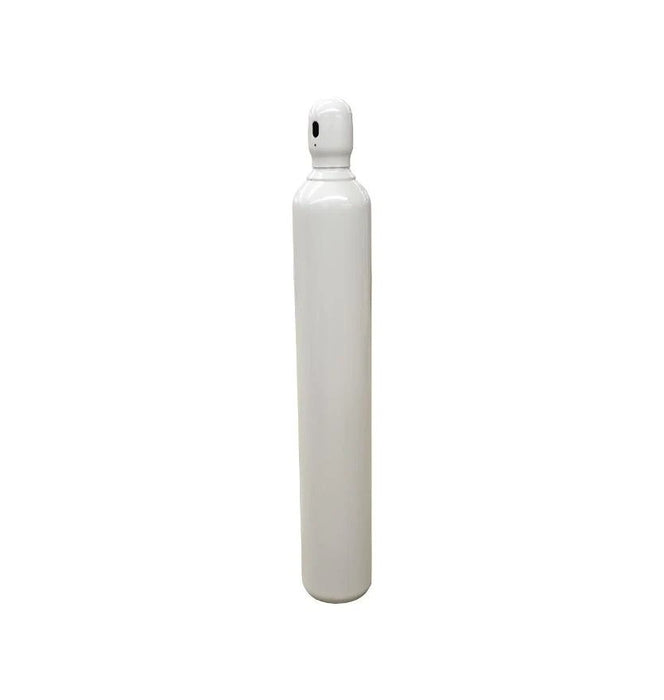
125 CF Welding Cylinder Tank Full 75% Argon 25% CO2 Welding Gas Cylinder Tank CGA 580 - FULL
⚠️WARNING: Cancer and Reproductive Harm

⚠️WARNING: Cancer and Reproductive Harm
A 125 CF Welding Cylinder Tank, filled with a gas mixture of 75% Argon and 25% Carbon Dioxide (CO2), and equipped with a CGA 580 valve, is a common choice in welding for specific applications. Here's a description of this welding cylinder:
Name: 125 CF Welding Cylinder Tank, 75% Argon / 25% CO2, CGA 580
Description: The 125 CF Welding Cylinder Tank is a high-capacity container designed to store and transport a gas mixture of 75% Argon and 25% Carbon Dioxide. This specific gas blend is commonly referred to as "75/25 Argon-CO2" or "75/25" and is used as a shielding gas in various welding processes, primarily MIG (Metal Inert Gas) welding. Here are some key features and details:
Capacity: The "125 CF" designation indicates the cylinder's capacity in cubic feet (CF). This size provides a significant volume of the 75/25 Argon-CO2 gas mixture, suitable for extended welding projects without frequent refills.
Gas Mixture: The cylinder is filled with a precise mixture of gases: 75% Argon and 25% Carbon Dioxide. This combination offers a good balance of inert shielding (from Argon) and improved arc stability and penetration (from CO2), making it suitable for welding carbon steel and some low-alloy steels.
Valve Type (CGA 580): The cylinder is equipped with a CGA 580 valve, which is the standard valve for Argon gas. This valve type ensures compatibility with the regulator or flow control device used to regulate the flow of the 75/25 Argon-CO2 gas mixture to the welding torch.
Full: The cylinder is described as "FULL," indicating that it is currently filled to capacity with the 75/25 Argon-CO2 gas mixture, ready for immediate use in welding applications.
Safety: Welding gas cylinders are designed with safety features, including robust steel construction and pressure relief devices, to ensure safe handling and storage.
Transportation: Welding cylinders may have built-in handles or caps for easy transport and handling, allowing them to be moved around the workshop or job site as needed.
A 125 CF Welding Cylinder Tank, filled with a gas mixture of 75% Argon and 25% Carbon Dioxide (CO2), and equipped with a CGA 580 valve, is a common choice in welding for specific applications. Here's a description of this welding cylinder:
Name: 125 CF Welding Cylinder Tank, 75% Argon / 25% CO2, CGA 580
Description: The 125 CF Welding Cylinder Tank is a high-capacity container designed to store and transport a gas mixture of 75% Argon and 25% Carbon Dioxide. This specific gas blend is commonly referred to as "75/25 Argon-CO2" or "75/25" and is used as a shielding gas in various welding processes, primarily MIG (Metal Inert Gas) welding. Here are some key features and details:
Capacity: The "125 CF" designation indicates the cylinder's capacity in cubic feet (CF). This size provides a significant volume of the 75/25 Argon-CO2 gas mixture, suitable for extended welding projects without frequent refills.
Gas Mixture: The cylinder is filled with a precise mixture of gases: 75% Argon and 25% Carbon Dioxide. This combination offers a good balance of inert shielding (from Argon) and improved arc stability and penetration (from CO2), making it suitable for welding carbon steel and some low-alloy steels.
Valve Type (CGA 580): The cylinder is equipped with a CGA 580 valve, which is the standard valve for Argon gas. This valve type ensures compatibility with the regulator or flow control device used to regulate the flow of the 75/25 Argon-CO2 gas mixture to the welding torch.
Full: The cylinder is described as "FULL," indicating that it is currently filled to capacity with the 75/25 Argon-CO2 gas mixture, ready for immediate use in welding applications.
Safety: Welding gas cylinders are designed with safety features, including robust steel construction and pressure relief devices, to ensure safe handling and storage.
Transportation: Welding cylinders may have built-in handles or caps for easy transport and handling, allowing them to be moved around the workshop or job site as needed.